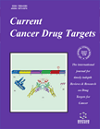- Home
- A-Z Publications
- Current Cancer Drug Targets
- Previous Issues
- Volume 13, Issue 2, 2013
Current Cancer Drug Targets - Volume 13, Issue 2, 2013
Volume 13, Issue 2, 2013
-
-
Therapeutic Implications of mTOR Inhibitors in the Treatment of Gastric Cancer
More LessGastric cancer remains one of the most common types of cancer worldwide, and most patients present with advanced disease. Sixty percent of these patients eventually relapse after curative surgical resection, and combination chemotherapy regimens only provide limited survival benefits. Mammalian target of rapamycin (mTOR) is a new target of cancer therapies. Preclinical data suggest that the suppression of the mTOR Read More
-
-
-
Dual Inhibition of PI3-Kinase and mTOR in Renal Cell Carcinoma
More LessAuthors: Daniel C. Cho and James W. MierAlthough PI3-kinase mutations are uncommon in renal cell carcinoma (RCC), the PI3-kinase/Akt signaling pathway is active in most RCC. The activation of PI3-kinase would be expected to drive protein and lipid synthesis through its effects on mTORC1 and SREBP1, respectively. PI3-kinase also activates numerous transcription factors (e.g. the FOXO family, c-myc, NF-κB) that regulate cell proliferation and viability. The conse Read More
-
-
-
Phosphatidylinositol 3-kinase Signaling as a Therapeutic Target for Cervical Cancer
More LessAuthors: Jianghong Wu, Chen Chen and Kong-Nan ZhaoCervical cancer is the second most frequent cause of female cancer mortality and remains a major health problem in women worldwide. Surgery, chemotherapy and radiotherapy alone or combined are the three treatments methods commonly used to treat this disease. However, a significant proportion of the cancer patients still experiences recurrence and eventually dies. Recently, the research advances in molecular profilin Read More
-
-
-
The PI3 Kinase Signaling Pathway in Prostate Cancer
More LessAuthors: Aymen A. Elfiky and Zhenyang JiangDespite recent advances in our understanding of the biological basis of prostate cancer, the management of the disease, especially in the castration-resistant phase, remains a significant challenge. Deregulation of the phosphatidylinositol 3-kinase (PI3K) pathway is increasingly implicated in a number of malignancies, including prostate carcinogenesis. In this review, we detail the role of this pathway in the patho Read More
-
-
-
Studies of NVP-BEZ235 in Melanoma
More LessAuthors: Joshua A. Sznol, Lucia B. Jilaveanu and Harriet M. KlugerThe PI3k pathway represents an attractive target for drug development in melanoma, as numerous studies have shown that this pathway is active in malignant melanocytes. In addition, previous work has shown that multi-level targeting of this pathway might be more effective than targeting the pathway at a single level. In this review, we discuss targeting different members of this pathway, potential escape mechanisms, clas Read More
-
-
-
Current Status and Future Perspectives of PI3K and mTOR Inhibitor as Anticancer Drugs in Breast Cancer
More LessAuthors: Xiaobei Zhang, Xi-ru Li and Jin ZhangThe PI3K/Akt/mTOR signaling pathway is involved in the inhibition of tumor cell apoptosis, the promotion of cell survival, cell cycle regulation, tumor angiogenesis, invasion, and metastasis and therefore plays an important role in tumorigenesis, tumor growth, patient prognosis, and tumor treatment. Recent studies have identified this signaling pathway in breast cancer, and the PI3K/Akt/mTOR pathway is therefore being co Read More
-
-
-
Novel Approaches for Molecular Targeted Therapy of Breast Cancer: Interfering with PI3K/AKT/mTOR Signaling
More LessAuthors: Thomas W. Grunt and Gabriella L. MarianiBreast cancer is one of the most prevalent and devastating malignant diseases in women worldwide. Fortunately, while breast cancer incidence is still increasing, its death rate is declining. This is mainly due to early diagnosis and potent therapies such as blockade of estrogen receptor- or of ErbB2 (HER2-neu) membrane receptorsignaling. In recent years, the PI3K/AKT/mTOR pathway, which transmits signals from the cell me Read More
-
-
-
Current and Potential Treatments for Cervical Cancer
More LessAuthors: Grace P.C. Yee, Paul de Souza and Levon M. KhachigianCervical cancer is the third most common carcinoma in women worldwide. Despite increasing efforts to improve therapy in this disease, a significant proportion of women still die, mostly from recurrent or chemoresistant disease. This review discusses current treatments for early cervical cancer, advanced disease, and recurrent cervical cancer, and covers concurrent chemoradiation, neoadjuvant chemotherapy b Read More
-
-
-
The miR-183/96/182 Cluster Regulates Oxidative Apoptosis and Sensitizes Cells to Chemotherapy in Gliomas
More LessAuthors: Hailin Tang, Yanhui Bian, Chaofeng Tu, Zeyou Wang, Zhibin Yu, Qing Liu, Gang Xu, Minghua Wu and Guiyuan LiMany microRNAs reside in clusters in the genome, are generally similar in sequence, are transcribed in the same direction, and usually function synergistically. The miR-183/96/182 cluster is composed of 3 miRNA genes, and increased expression of miR-183, 96 and 182 are implicated in glioma carcinogenesis. Knockdown of individual components or of the entire miR-183/96/182 cluster inhibits the survival of glioma cells Read More
-
Volumes & issues
-
Volume 25 (2025)
-
Volume 24 (2024)
-
Volume 23 (2023)
-
Volume 22 (2022)
-
Volume 21 (2021)
-
Volume 20 (2020)
-
Volume 19 (2019)
-
Volume 18 (2018)
-
Volume 17 (2017)
-
Volume 16 (2016)
-
Volume 15 (2015)
-
Volume 14 (2014)
-
Volume 13 (2013)
-
Volume 12 (2012)
-
Volume 11 (2011)
-
Volume 10 (2010)
-
Volume 9 (2009)
-
Volume 8 (2008)
-
Volume 7 (2007)
-
Volume 6 (2006)
-
Volume 5 (2005)
-
Volume 4 (2004)
-
Volume 3 (2003)
-
Volume 2 (2002)
-
Volume 1 (2001)
Most Read This Month
Article
content/journals/ccdt
Journal
10
5
false
en


